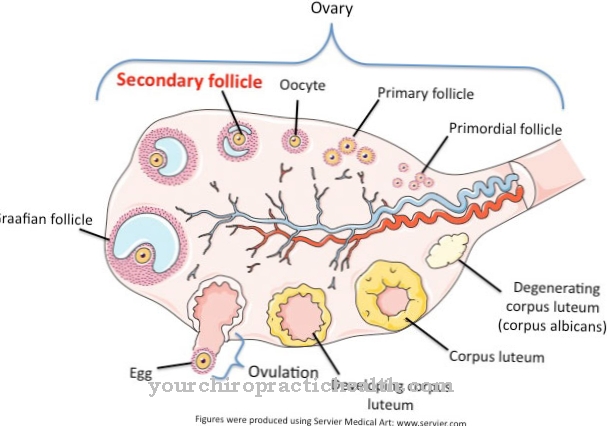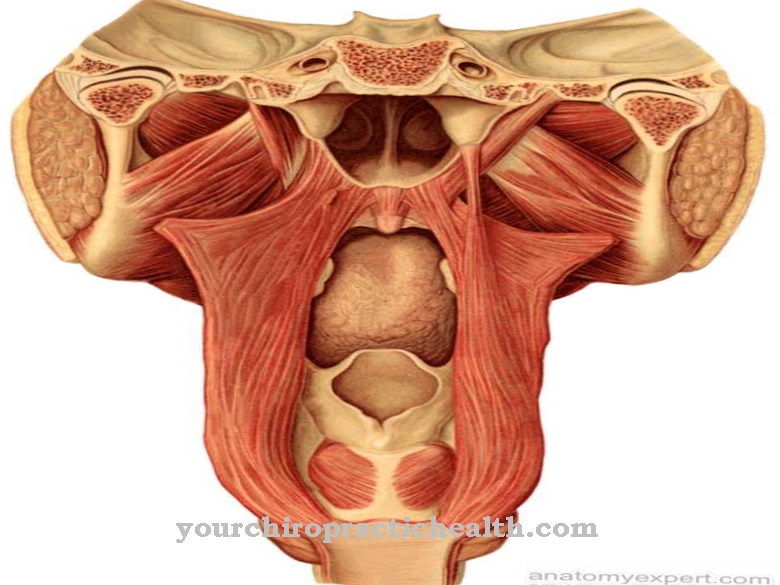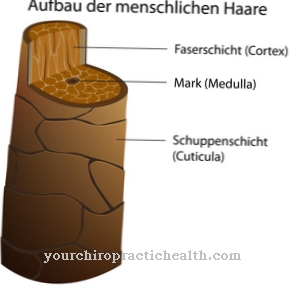The Sacrum and iliac joint is the link between the pelvis and the spine. It has an important function due to the heavy daily use of this body region. The high load on the joint, however, also favors the easy development of painful complaints.
What is the sacrum and iliac joint?
With Sacrum and iliac joint (also sacrum-iliac joint,
Sacroiliac joint - in short: ISG, Sacroiliac joint) the joint joint on both sides of the sacrum (Sacrum) and iliac bone (Os ilium) designated.The joint is located between the 1st and 3rd sacral vertebrae. Since it is surrounded by tight ligaments that severely restrict the range of motion, it is a so-called "amphiarthrosis" (Greek: amphi = around, around and arthros = joint). Occasionally, the SIJ is referred to as a "fake" joint due to its minimal mobility.
In addition to the sacrum and iliac joint, the joints between the tarsus and wrist bones are also amphiarthroses. Despite its internally restricted flexibility, the sacroiliac joint plays an important role in the entire human musculoskeletal system. This is where the power transmission from the upper body and legs takes place.
Anatomy & structure
The sacrum consists of five fused vertebrae and forms the stable base of the spine. It is located above the tailbone, under the lumbar vertebrae. The iliac bone makes up a large part of the pelvis, it extends from the iliac crest to the hip joint. The L-shaped sacrum-iliac joint connects the two bony surfaces that meet (facies auricularis) of these bones. As with all joints, they are each covered with articular cartilage (ligamenta sacroiliaca interossea) and connective tissue fibers and are surrounded by strong, supportive ligaments. The sacroiliac joint lies in a narrow joint cavity and has only a small joint space. It is only designed for the transmission of small forces, the surrounding ligaments have to compensate for strong forces and pressure in order not to overload the joint.
The nature of the sacrum and iliac joint changes in the course of life depending on gender. In men, the flexibility of the joint decreases with advancing age - up to and including joint blockage. The reason for this is the increasing irregularity of the bony surfaces, which are still smooth in young people. In women, the sacroiliac joint remains comparatively more flexible, but here, too, there are age-related signs of wear and tear.
Function & tasks
The iliac and sacrum support the entire load of the upper body and are therefore highly stressed parts of the human musculoskeletal system. The sacrum and iliac joint as their connection point also has an important function. It helps transfer the weight of the upper body to the lower limbs and is part of the elastic stabilization of the trunk.
Supported by tight fibers and ligaments, the sacroiliac joint has almost no freedom of movement despite its joint function, as it mainly has power-transmitting functions. The flexibility of the joint is limited to just 1-2 ° rotational movement or 2-4 mm mobility in each direction (so-called nutation and counter-nutation). The heavy strain on the lower back requires this tight fixation. The joint is particularly stressed in everyday life in a sitting position.
Under certain circumstances, a sacroiliac joint can be more mobile than its counterpart on the other half of the body. In addition to anatomical causes, this functional asymmetry can also be caused by too one-sided movement stress. In principle, female sacrum and iliac joints show greater mobility, as the nature and position of the joint surfaces that meet are more functional than in men.
This fact plays an important role especially in childbirth. As a result of hormonal effects during the birth process, the ligaments that fix the joint soften and thus allow the joint zone to stretch. This increases the diameter of the pelvis and makes it easier for the child to pass.
You can find your medication here
➔ Medicines for back painIllnesses & ailments
Research has shown that pathological changes in the sacrum and iliac joint are responsible for up to 25 percent of lower back pain. People with a predisposition for weak ligaments are particularly at risk of developing diseases in the area of the joint.
Overstretched ligaments can lead to overmobility of the joint due to a lack of support. This promotes degenerative changes, such as hardened bones, which represent a countermeasure for the body to stabilize the joint.
Rheumatic complaints also frequently occur in the sacroiliac joint area and can sometimes cause severe pain. In particular, complaints related to ankylosing spondylitis often occur in this region of the body.
Finally, abrupt movements during exercise or as part of accidents can lead to lesions or painful complaints in the sacrum-iliac joint. Lifting heavy loads incorrectly or “stepping into space” often results in joint injuries and can lead to so-called ISG blockages.
Long periods of sitting at work, lack of exercise and untreated misalignments of feet, knees and hips can also damage the joint in the long term. Inflammation, strains and other diseases in the area of the sacroiliac joint are expressed in the form of pain in the buttocks area that is sometimes severe, often one-sided and localized. The pain can radiate into the groin and lumbar region.
This can also lead to tingling and other abnormal sensations. Often the symptoms mainly occur in a sitting position, while walking and standing are more pain-free. Targeted training of the surrounding muscles can help relieve the sacrum and iliac joint and thus alleviate the symptoms. In addition, pain-relieving injections and, if necessary, surgical interventions can be appropriate.



























